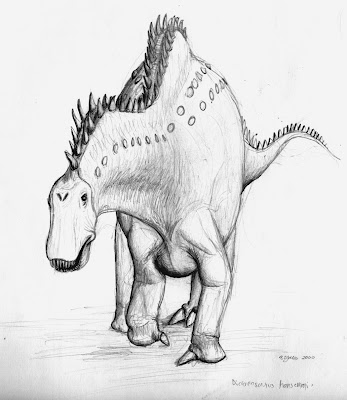
Hagfish from www.itsnature.org
Hi folks, Yes its been quiet here on Dracovenator. School is back on, and I have a hectic 16 hours of teaching a week which coupled with a newborn in the house is leaving me kind of exhausted. In anycase I'm going to give voice to a few thoughts that flashed through my mind when I read the abstract for the latest dinosaur taxon to be named from the Jehol Group of Liaoning. I haven't seen the paper yet, someone want to forward the pdf?, So this should all be read as speculative thoughts and nothing more. Firstly I'm sure you are are wondering why the hell I've put up a picture of a hagfish, of all things, to illustrate a post about a dinosaur, well read on....
Similicaudipteryx yixianensis He et al. 2008 is described as a caudipterygiid oviraptorosaur in the latest Vertebrata Palasiatica. For those who may need reminding, Caudipteryx was one of the first non-avian theropods discovered with a plumage of undeniable pennaceous feathers. As one could have expected the 'BAND' didn't take to kindly to the idea of fully plumed non-avian theropod dinosaur and they fairly quickly responded with claims that Caudipteryx was actually a true bird that had become secondarily flightless and ground-dwelling. Indeed there is something terribly birdy about the incredibly stump-tailed Caudipteryx and its wing-like hand with a highly reduced third digit.
 A very nice model skeleton of Caudipteryx. From www.dinocasts.com
A very nice model skeleton of Caudipteryx. From www.dinocasts.comThese observations have occurred to many and even Stephen Gould wrote an essay about how blurry the bird-dino distinction had become and in this case he thought us dino palaeontologists had got it wrong. In anycase it didn't take long for people to see that Caudipteryx shared much with the mid to late Cretaceous Oviraptorosaurs. It has always been puzzling how many bird-like features Oviraptorosaurs display that are not present in the Deinonychosauria which is the currently accepted sister group of birds. These have been largely thought of as convergences because comprehensive cladistic analyses routinely place them outside the clade of Deinonychosauria + Birds. Why is this? Well for all their birdiness oviraptorosaurs have a suite of plesiomorphies including (but not limited to) a straight(versus bowed) metacarpal three , a deep ilium with a post-acetabular process that exceeds in length the pre-acetabular process, and a forwardly directed pubis with an anteriorly and posteriorly expanded boot. Now along comes Similicaudipteryx and adds a couple more bird-like features that are not seen in deinonychosaurs. One is the presence of deep hypapophyses on the anterior dorsal vertebrae and a pygostyle on the end of the tail. The latter had been previously reported in the oviraptorosaur Nomingia but had been dissmissed as convergence since other oviraptorosaurs apparently didn't have one. Similicaudipteryx raises the spectre that pygostyles may have been primitive for oviraptorosaurs and lost in later taxa (or simply not present because the material was not mature enough in the case of Caudipteryx). One more little observation before we can finally get to slime-hags: The undoubted volant pygostylian bird, Sapeornis, also from Liaoning, has a remarkably caudipterygiid-like skull as noted by Stephen Czerkas when he briefly described a specimen (under the name Omnivoropteryx).
Now to hagfish. Although the dust (slime?) hasn't settled on the controversy over their systematic position, it seems that the evidence for cyclostome monophyly (that is lampreys + hagfish) is growing. Now that is deeply uncomfortable to those used to working with morphology, since everything about hagfish seems to shout that they are basal to lampreys + jawed vertebrates. For instance they lack extrinsic eye muscles, innervation of the heart, vertebrae of any sort and muscles in the caudal fin. Nonetheless it looks like hagfish really are an example of pervasive, wholesale reversion to a more primitive condition. There are other less extreme examples of this phenomenon. For instance gavials are now firmly placed as the sister-group to tomistomines (false gavials) within Crocodylidae (based on combined, morphological and molecular analyses, including fossils) they have a suite of plesiomorphies throughout the skeleton that initially confounded morphological cladistic analyses by place gavials at the base of modern Crocodylia.

Wholesale taxic atavism in gavials. A graphic representation of morphological characters that place gavials on a more basal branch of crocodylian phylogeny. From Gatesy et al. 2003.
Gatesy et al. 2003 called this pervasive reversal 'wholesale taxic atavism'. Note that it does not appear to be the result of sustained selection for any particular ecophenotype. False gavials are also longirostrine fish-eaters but lack the wholesale atavism seen in gavials. This to my mind is a very interesting and understudied aspect of evolution.
Whatever its cause I'd like to suggest that Oviraptorosauria might end up being yet another example. If this is so I will predict that as we get a better fossil record of maniraptorans from the latest Jurassic and the Earliest Cretaceous we will find earlier and earlier oviraptorosaurs that get more and more like pygostylians. Maybe we will find a volant or recently ex-volant sapeornithid-caudipterygiid intermediate. Of course I could just be jumping the gun....
references
Gatesy J, Amato G, Norell M, DeSalle R and Hayashi C (2003) Combined Support for Wholesale Taxic Atavism in Gavialine Crocodylians. Systematic Biology, 52(3): 403 — 422
He T, Wang X-L, and Zhou Z-H (2008). A new genus and species of
caudipterid dinosaur from the Lower Cretaceous Jiufotang Formation of
western Liaoning, China. Vertebrata PalAsiatica 46(3):178-189.













